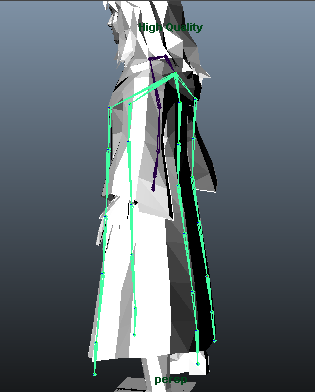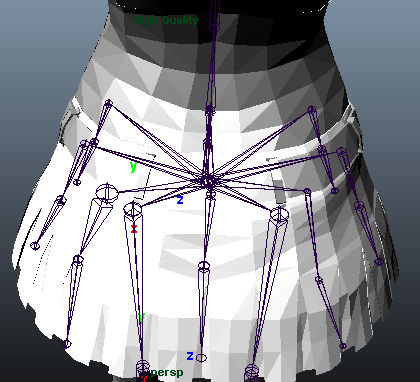For the skirt, I looked a lot at how technical artists usually model skirts for games. There are a lot of forums debating on the best way to do it, such as here on Tech-Artists.org
http://tech-artists.org/forum/showthread.php?4382-Rigging-a-Skirt-for-games
This was in reply to techniques of how to rig a 3D skirt for movement:
This mentions simulating cloth physics for the skirt, as well as the use of joints to rig the skirt alongside IK splines to connect them for movement. Many tutorials for skirt rigging recommend using cloth physics such as nCloth in Maya in this Digital Tutors tutorial: http://www.digitaltutors.com/tutorial/860-Introduction-to-nCloth-in-Maya#play-22614. While this does create realistic motion for 3D modelled skirts, using cloth simulation in games would be costly to import the model and animations into a game engine. Many engines have their own physics, but for my rig I wanted to use joint chains to control the movement of the skirt because although adding more joints to a rig makes it more complex for the engine, it is less expensive than using cloth simulation. The third point of the above forum post; using two IK splines for the joint chains involved that would move with the leg and another that would move by the animators controls is something I will look more into when I focus more on the skirt later in the project.
In order to find out the best way to use joints to rig the skirt, I looked around for tutorials that used only joints and also models that used joints instead of cloth simulation. In this model I found of Hermione from the Harry Potter & The Prisoner of Azkaban game from here http://tf3dm.com/3d-model/harry-ron-hermione-23306.html :
She is wearing a robe which is rigged using joint chains for movement instead of cloth simulation, and the joints are placed close to the outside of the robe, which would allow these joints to move the robe mesh.
Additionally I found this tutorial video (in Blender)
https://www.youtube.com/watch?v=oRuQFJKT2Xg
The main focus of this tutorial was to rig the skirt without using cloth simulation, and therefore uses a set of control bones which are placed around the outside of the skirt. These bones are then set to conform to the legs so that they will move when the legs move by using constraints. Although this skirt is different to mine because it is long, its useful to think about constraints to move the joints, and how I could make the cloth hang realistically depending on the way the legs have moved.
For my skirt, I used a similar method to set up the structure of it so I could apply constraints later for movement. From the root joint, I created joint chains around the skirt in 8 directions, with 3 joints each. Although this makes the rig more complex it will allow the rig to move the skirt without using cloth simulation, and its important for the skirt to move because of the type of freedom the character will be required to do, such as cheerleader movements by kicking her leg in the air. The skirt would pass through her leg when she did this if it wasn’t rigged and didn’t have constraints. I could have made more joints for the skirt but I didn’t want to have too many joints in the rig as this could hinder the performance of the animations in the game which need to run in real-time.
When it comes to refining my rig I will add constraints to the skirt so the joints move appropriately with the legs and movement of the character.
Sources:
http://tech-artists.org/forum/showthread.php?4382-Rigging-a-Skirt-for-games
http://www.digitaltutors.com/tutorial/860-Introduction-to-nCloth-in-Maya#play-22614



